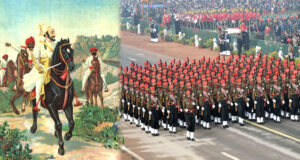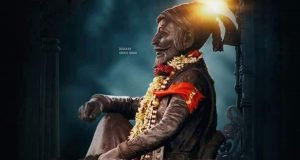
हे आहे एक ‘इस्ट इंडियामन’. अशाच प्रकारच्या व्यापारी जहाजांवर बसून इंग्रज, डच, आणी फ्रेंच भारतात आले.
या जहाजात मालासोबत तोफखानाही असे, तसेच एक तुकडी शिबंडीची असे. जेणेकरून, समुद्रावर शत्रूशी गाठ पडल्यास त्याच्याशी मुकाबला केला जाऊ शकतो.
एका जिद्दी कॅप्टनच्या हाताखाली एक इंडियामन बऱ्याच भारतीय प्रकारच्या गलबतांना झुंझत ठेऊ शकतो.
शिवकाळात, इंडियामन जहाजांना भारताच्या कोणत्याच राज्याने लढाईत जिंकले नाही आणी अशाच प्रकारच्या जहाजांना आवाहन मराठ्यांनी दिलं. कडवे आवाहन दिलं, झुंज दिली, आणी विजय पताका मिरवली.
East Indiaman was a general name for any ship operating under charter or licence to any of the East India Companies of the major European trading powers of the 17th through the 19th centuries. The term is therefore used to refer to vessels belonging to the Danish, Dutch, English, French, Portuguese, or Swedish East India companies.
Some of the East Indiamen chartered by the British East India Company were known as “tea clippers”.
East India Company itself did not generally own merchant ships, but held a monopoly granted to it by Queen Elizabeth I of England for all English trade between the Cape of Good Hope and Cape Horn, which was progressively restricted during the late 18th and early 19th centuries. British East Indiamen usually ran between England, the Cape of Good Hope and India, where their primary destinations were the ports of Bombay, Madras and Calcutta. The Indiamen often continued on to China before returning to England via the Cape of Good Hope and Saint Helena.
An English East Indiaman, bow view (circa 1720) Peter Monamy
Review Overview
User Rating !
Summary : अशा व्यापारी जहाजांवर बसून इंग्रज, डच, आणी फ्रेंच भारतात आले. या जहाजात मालासोबत तोफखानाही असे, तसेच एक तुकडी शिबंडीची असे. जेणेकरून, समुद्रावर शत्रूशी गाठ पडल्यास त्याच्याशी मुकाबला केला जाऊ शकतो.
 Chhatrapati Shivaji Maharaj – Shivray छत्रपती शिवाजी महाराज Shivba Shivajiraje Shivprabhu Chatrapati Shivaji Maharaj
Chhatrapati Shivaji Maharaj – Shivray छत्रपती शिवाजी महाराज Shivba Shivajiraje Shivprabhu Chatrapati Shivaji Maharaj





